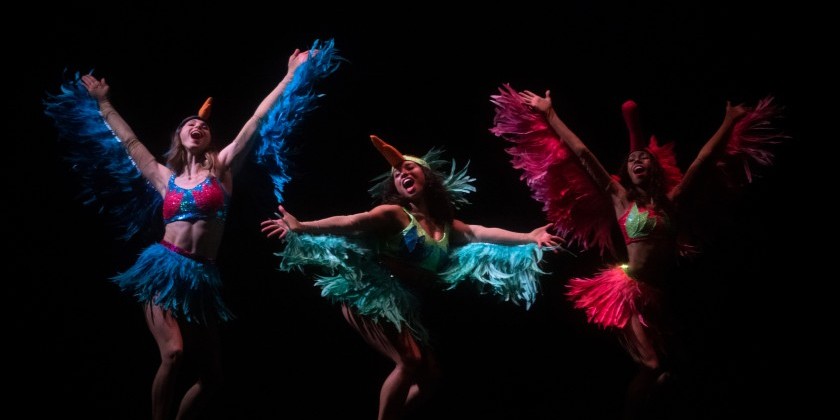IMPRESSIONS: "THE NIGHT FALLS," a BalletCollective and PEAK Performances Production, with Choreography by Troy Schumacher

A Parable for our Times
Book and Lyrics: Karen Russell
Music and Lyrics: Ellis Ludwig-Leone
Direction and Choreography: Troy Schumacher
Performers:
"Felisberto" Amari Frazier (dancer),David Merino (singer);
"Angela" Dabria Aguilar (dancer), Olivia Puckett (singer)
"George" John Selya (dancer), Alexander Dobson (singer)
"Nadia" Laurie Kanyok (dancer), Ilene Pabon (singer)
"Allan" Brendon Chan (dancer), Allen Tate (singer)
"Jarvis" Reed Tankersley
Siren Singers: Eliza Bagg, Claire Wellin, Angela Yam
Sirenette/Sufferer Dancers: Kellie Drobnick, Katarina Smith, Tatiana Nuñez
Sufferers: Sam Assemany, Nicole Ashley Morris, Courtney San Martin, Joshuan Vázquez,
The Night Falls Musical Ensemble: Isabel Gleicher (Flute), Kristina Teuschler (Clarinet), Nicolee Kuester (Horn), Daniel Schlosberg (Piano), Chelsea Lane (Harp), Jeremy Smith and David Stevens (Percussion), Benjamin Russell (Violin), Hannah Levinson (Viola), Clare Monfredo (Cello)
February 9 - 12, 2023
The Night Falls follows the lives of six displaced seekers who hear a beguiling melody in their sleep and on television. Seduced by three monster sirens existing in an off-the-grid Florida grotto, called The Night Falls, the melody entreats them to leave their homes and uncover answers to heal their broken spirits. The disoriented seekers share their stories in dance and song, eventually saving one of their number from doom. Individuals evolve into a forceful community that defies seduction and acts as a healing force.
As Troy Schumacher (direction and choreography, founder of BalletCollective) declared at a Works & Process symposium on January 22, community “offers an antidote to division. You have to listen to other people. How do you form a community when all is almost lost?”
Added Ellis Ludwig-Leone (music and lyrics), “Community-building is the best thing we can do to create a better life for ourselves and for other people.” Each alone endures until the many “brace themselves together” and move “into dawn and possibility.” (Karen Russell, book and lyrics).

This movement-driven, three act, 70-minute musical theater opera eludes strict categorization. It is a “hybrid model,” said Ludwig-Leone. Conceived in 2017 on Zoom, the work began as a response to the repetitive trauma of mass shootings and the then current political climate. Development continued through the Covid-19 pandemic reflecting the burden of isolation and the longing to come together. The Night Falls offers a path to societal healing.
At the dance’s premiere at PEAK Performances, Montclair State University, a magical depiction of Florida introduces Act I. An earworm-melodied commercial, “Come to Flo Ri Da!” features three alluring, brightly colored egret women. The egrets open and close feathered arms, chugg feathered hips from side to side, and bob beaked heads while they smilingly sing, “Mega Flora, Mega Fauna, It will never leave your head. Count down and swoon! This weekend come with us to a celestial tailgate, at The Night Falls.” This light-hearted jingle evolves into a devastating siren song that becomes a force throughout the production.

Danced by the expansive Amari Frazer, Felisberto, the despairing protagonist whose boyfriend recently died, hears the scorched melody sung by three monster sirens in his nightmare. He awakens, turns on the television and sees the commercial. The monster sirens double as the beckoning birds. They magically split him in two, forcing a danced and sung response.

Elegantly phrased movement of bended slow reaches, high arched arabesque turns, a side bend with tucked elbow and soft neck, an adagio sweep of the arm, and small hops and large kicks hit the right notes of Felisberto’s pathos and longing to heal. Accompanied by the exquisite tenor, David Merino, this dance and song are the first of several solos. Each dancing character is mirrored by a singer-double situated on a platform above the stage.

The six characters make their way to the dark and eerie grotto. George (the satisfyingly weighted John Selya), in a deep lunge on bended knee, in Lola’s Song, proposes and appeals to his hopeful yet ever distrustful wife. The tennis star, Angela (Dabria Aguilar), whose taffy-like extensions allow a glimpse of her desire, runs from side to side to reach the ball. Again, she has missed and lost.

The solos toggle between similar and sophisticated. Each beseeching soloist stands in front of members of the encircling group. The responder shakes an empathetic head or answers with a larger movement. This sameness and the too often undistinguished movement vocabulary outweigh moments of transcendence in the ethereal music. The production’s structure is back-to-back solo heavy. The solos puddle together.

A notable exception is Felisberto’s final solo. He is the last character to tell his story, in the poignant scene, Remedios, which brings all aspects of the production to a high mark of movement, music and lyrics. Its full title is Remedios caseros para un corazón herido (Home remedies for a wounded heart). On staggered counts, Felisberto bends forward deeply with hands covering his ears to block the siren song. All follow suit. Giving into his pain, he catapults into the void of the grotto, bewitched by the siren melody. In reaction, the group holds hands and calls for Felisberto. They circle and then rush diagonally to and fro searching as the curtain falls on Act II.
.jpg)
The girded group pulls Felisberto back to the living in Act III. One leg swinging forward and back in attitude while hopping begins with one mover and builds to group unison. Jetés, turns in attitude, circles formed in arabesque, consecutive leaps, hops, and stutter steps characterize the traveling movement. Felisberto, while in the grotto, restores the monster sirens to their human selves. The bifurcated characters, dancers and singers, hug one another and join the group. They, too, have become whole. “Love”, they sing. The final vision is one of three egrets serenely flying across the sky above the grotto.

The elaborate production is masterfully directed, written, designed and composed, from the inventive set design to the charmingly alive projections to the 10-piece orchestra. The memorable singers and the dancers, who originate from diverse dance practices, unite to create a parable for our time.













